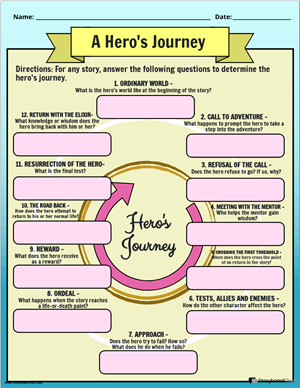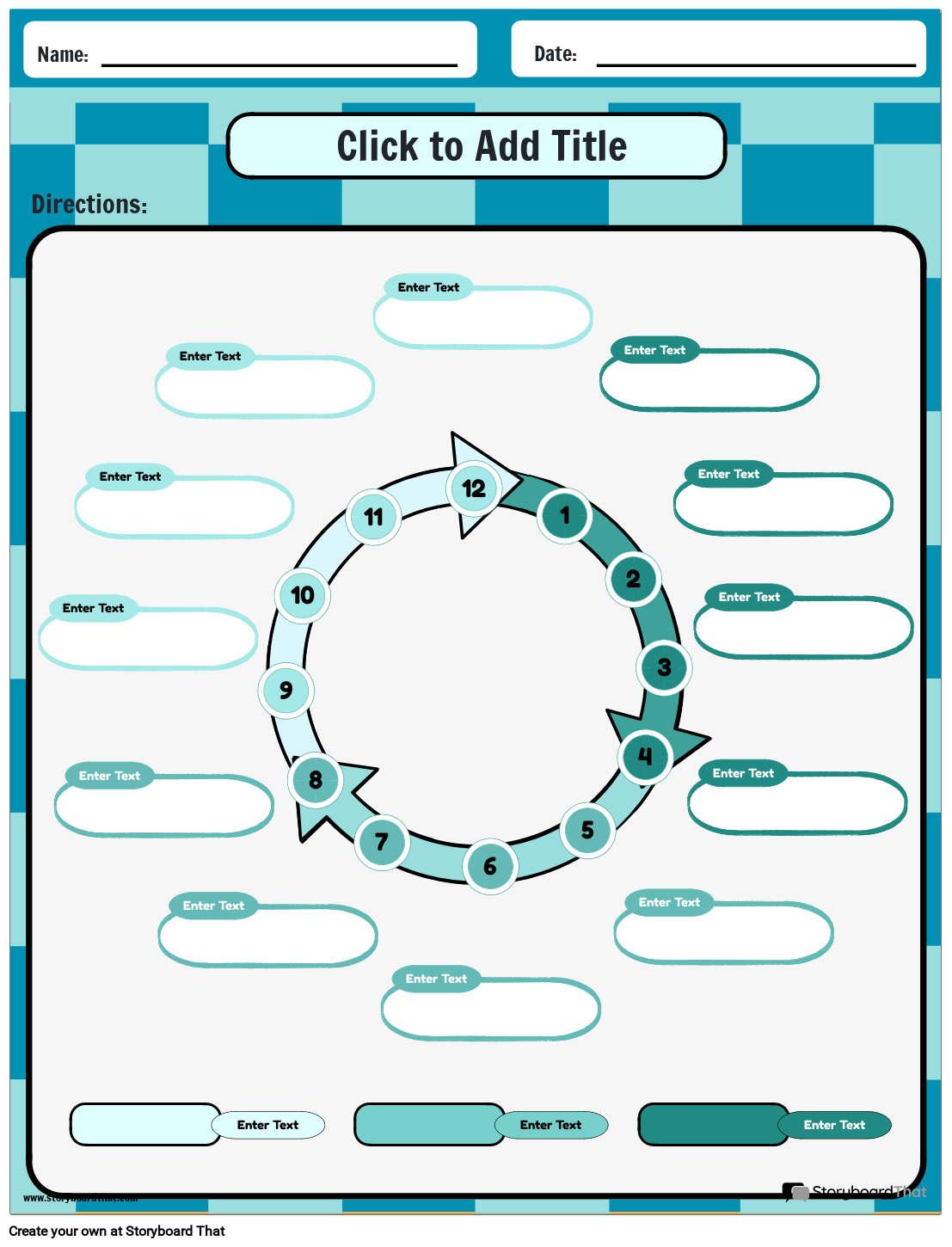Customize Hero's Journey Worksheets
If you're assigning this to your students, copy the worksheet to your account and save. When creating an assignment, just select it as a template!

Joseph Campbell Hero's Journey Worksheets
Joseph Campbell definition of a hero, or the monomyth, is a basic pattern found in many narratives, myths, and stories across cultures. Based on Joseph Campbell's definition of a hero, the storyline follows an archetypal protagonist as they transform through a journey. These worksheets can be a useful teaching tool to engage students in analyzing this common plot structure and recognizing it across texts, or even movie films. In this blog post, we will explore what a this progression is, the benefits of these worksheets, and how teachers can effectively integrate them into the class.
What is a Hero's Journey Chart?
This chart is a graphic organizer that maps out the narrative structure of the monomyth. Having kids fill out a chart is an activity that develops critical thinking as they analyze the events of a narrative and categorize them into the correct stage.
There are many versions of monomyth charts available. Most include the key stages or plot points typical of one of these stories: the ordinary world, call to the quest, refusal of the call, meeting a mentor, stepping across the threshold to a new world, tests/enemies, approach to the inmost cave, the conflict, the reward for overcoming the conflict, the road back, resurrection, and return with the elixir. A chart tracks the protagonist through each stage of this transformative story.
Hero's Journey Stages: From the Ordinary World and Back Again
Using these worksheets, students explore how the protagonist undergoes change in each stage:
- Ordinary World: The protagonist's everyday life.
- Call to Adventure: The protagonist is needed for a quest.
- Refusal: At first, the protagonist is reluctant to embark on the mission.
- Mentor: The protagonist has help or guidance from a mentor figure.
- Crossing the Threshold: The protagonist enters the new world.
- Tests, Allies, Enemies: The protagonist faces trials, meets friends and foes.
- Approach to the Cave: Preparing for the biggest obstacle.
- Supreme Ordeal: The ultimate crisis point.
- Reward: The protagonist receives some prize for passing the situation.
- The Road Back: The return begins.
- Resurrection: A final challenge that may arise.
- Return: They return, transformed.
Exploring each stage brings depth to literary or movie analysis. Kids come to understand the archetypal storyline that connects so many storied heroes, in both film and literature.
Tips for Using Hero's Journey Worksheets
Here are some tips on integrating these worksheets into your ELA, film, or mythology lessons:
- Use as a Pre-Reading Activity: Distribute blank hero’s journey chart graphic organizers and have your class speculate on key narrative events before reading a story. After reading, they can compare their guesses to the actual plot progression of the film or book.
- Review Story Structure: After reading a monomyth narrative like The Odyssey, have your class complete printable worksheets to reinforce understanding of narrative structure. Additional activities could include analyzing Odysseus's hero's journey in Homer's Odyssey or comparing Odysseus to an epic hero.
- Literary Analysis: Provide excerpts from novels or short stories for kids to analyze. Have them use the hero’s journey worksheet free online to identify stages in the passages. They could also examine examples of archetypes and types of heroes in literature like the tragic hero or antihero.
- Write Your Own Story: Your class can apply the monomyth template to plan an original narrative for a protagonist of their choice. Understanding the qualities of an everyday hero could inspire ideas.
- Compare Hero’s Journeys: Give your class different worksheets for literary and film characters such as Odysseus (The Odyssey), Luke Skywalker (Star Wars), Harry Potter, or Frodo (Lord of the Rings). Have them compare and discuss the journeys using the data. Comparing journeys of a tragic hero like Othello or Macbeth could also yield insightful discussion.
Integrating analysis of different literary or film protagonist types and examples deepens students' understanding of the monomyth template.
Why Use a Hero's Journey Graphic Organizer?
Integrating a graphic organizer into English or mythology lessons when teaching archetypes offers numerous benefits for learning and engagement. Using a graphic organizer facilitates critical analysis as students map the narrative progression of a story. They identify how plot structure aligns with the stages of the monomyth template conceived by Joseph Campbell in his analysis of world monomyths.
As your class completes printable hero’s journey worksheets, they build deeper comprehension of fundamental storytelling elements and archetypes. Recurring figures like threshold guardians, the trickster, or the shapeshifter become familiar. Recognizing these story conventions for archetypes across myths, literature, and movie examples creates connections. For example, the presence of enemies, tests or supreme ordeals before the climactic resolution, and the transformative nature of the experience.
Comparing completed worksheets for different protagonists also grows appreciation for archetypes and the monomyth concept. For instance, contrasting graphic organizers charting Odysseus’ long voyage home to Ithaca with watching Luke Skywalker’s life and galactic quest in a movie format emphasizes similarities in these archetypes despite vastly different settings. As Carl Jung the father of archetypal psychology described, archetypes resonate across cultures and eras through symbols in the collective unconscious.
Further, exposure to the heroic journey blueprint can boost creative writing. Your class can invent and write about original heroes and plot a quest story incorporating stages of the monomyth outline. The ordinary world, call to the quest, stepping from the first threshold into the unknown, road of trials, and thrilling climactic resolution become waypoints on their protagonist’s transformation. Internalizing this storytelling structure empowers the imagination.
In all, integrating analysis of monomyth plots using worksheets, charts, and graphic organizers offers multifaceted benefits for student learning. It stretches critical thinking while elucidating recurring narrative patterns for archetypes that speak to primal parts of the human psyche.
How to Make a Hero's Journey Worksheet
Choose One of the Premade Templates
We have lots of templates to choose from. Take a look at our example for inspiration!
Click on "Copy Template"
Once you do this, you will be directed to the storyboard creator.
Give Your Worksheet a Name!
Be sure to call it something related to the topic so that you can easily find it in the future.
Edit Your Worksheet
This is where you will include directions, specific images, and make any aesthetic changes that you would like. The options are endless!
Click "Save and Exit"
When you are finished, click this button in the lower right hand corner to exit your storyboard.
Next Steps
From here you can print, download as a PDF, attach it to an assignment and use it digitally, and more!
Happy Creating!
Frequently Asked Questions about Hero's Journey Worksheets
What does a charting the hero's journey worksheet involve?
A charting the hero's journey worksheet maps out the narrative structure of a story onto the template of the hero's journey. This type of graphic organizer has sections for each stage of the monomyth, including departure, initiation, and return.
What are the stages of the hero's journey worksheet?
Some key stages often included on a hero's journey worksheet or chart are: the ordinary world, call to adventure, crossing the first threshold, meeting allies/enemies, road of trials, approaching the inmost cave, supreme ordeal, seizing the reward, the journey home, resurrection of final challenge, and return with the elixir.
Why teach the stages of the hero’s journey?
Learning the stages of the hero’s journey benefits students in multiple ways. It builds story analysis skills as students map plot structure onto the monomyth template. Recognition of story patterns and archetypes across myths and literature improves literacy. Creative writing is enabled as students incorporate heroic journey elements into original protagonists and adventures.
© 2026 - Clever Prototypes, LLC - All rights reserved.
StoryboardThat is a trademark of Clever Prototypes, LLC, and Registered in U.S. Patent and Trademark Office
















